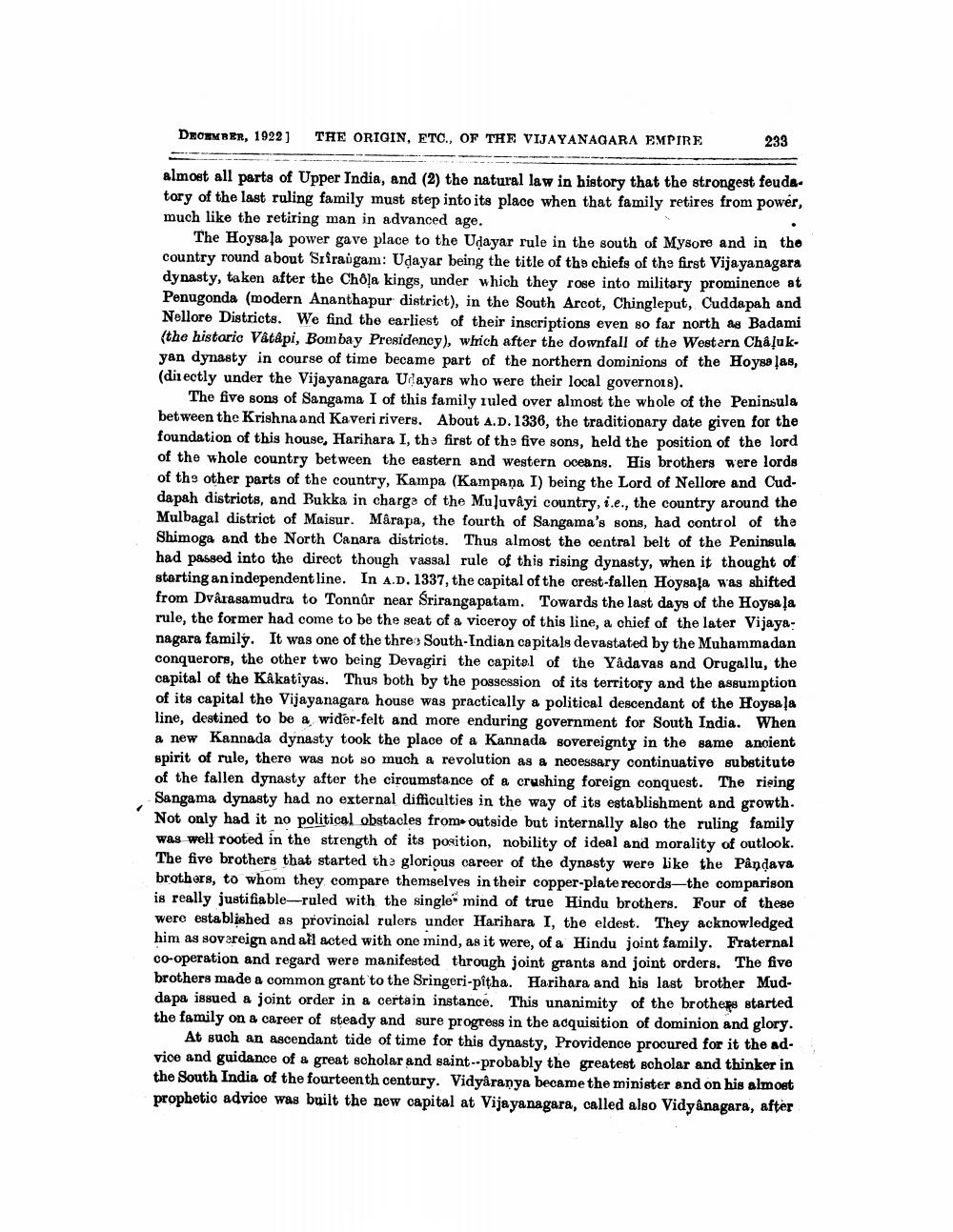________________
DROHMBER, 1922)
THE ORIGIN, ETC., OF THE VIJAYANAGARA EMPIRE
233
almost all parts of Upper India, and (2) the natural law in history that the strongest feudatory of the last ruling family must step into its place when that family retires from power, much like the retiring man in advanced age.
The Hoysala power gave place to the Udayar rule in the south of Mysore and in tho country round about Sriraugam: Udayar being the title of the chiefs of the first Vijayanagara dynasty, taken after the Chôļa kings, under which they rose into military prominence at Penugonda (modern Ananthapur district), in the South Arcot, Chingleput, Cuddapah and Nellore Districts. We find the earliest of their inscriptions even so far north as Badami (the historie Vacapi, Bombay Presidency), which after the downfall of the Western Chåļuk. yan dynasty in course of time became part of the northern dominions of the Hoysa ļa8, (directly under the Vijayanagara Urlayars who were their local governois).
The five sons of Sangama I of this family ruled over almost the whole of the Peninsula between the Krishna and Kaveri rivers. About A.D. 1336, the traditionary date given for the foundation of this house, Harihara I, the first of the five song, held the position of the lord of the whole country between the eastern and western oceans. His brothers were lords of the other parts of the country, Kampa (Kampaņa I) being the Lord of Nellore and Cuddapah districts, and Bukka in charge of the Muluvâyi country, i.e., the country around the Mulbagal district of Maisur. Mârapa, the fourth of Sangama's sons, had control of the Shimoga and the North Canara districts. Thus almost the central belt of the Peninsula had passed into the direct though vassal rule of this rising dynasty, when it thought of starting anindependent line. In A.D. 1337, the capital of the crest-fallen Hoysaļa was shifted from Dvarasamudra to Tonnûr near Srirangapatam. Towards the last days of the Hoysa la rule, the former had come to be the seat of a viceroy of this line, a chief of the later Vijaya. nagara family. It was one of the thre South-Indian capitals devastated by the Muhammadan conquerors, the other two being Devagiri the capital of the Yadavas and Orugallu, the capital of the Kåkatiyas. Thus both by the possession of its territory and the assumption of its capital the Vijayanagara house was practically a political descendant of the Hoysala line, destined to be a wider-felt and more enduring government for South India. When a new Kannada dynasty took the place of a Kannada sovereignty in the same ancient spirit of rule, there was not so much a revolution as a necessary continuative substitute of the fallen dynasty after the circumstance of a crushing foreign conquest. The rieing Sangama dynasty had no external difficulties in the way of its establishment and growth. Not only had it no political obstacles from outside but internally also the ruling family was well rooted in the strength of its position, nobility of ideal and morality of outlook. The five brothers that started the glorious career of the dynasty were like the Pândava brothers, to whom they compare themselves in their copper-plate records—the comparison is really justifiable--ruled with the single mind of true Hindu brothers. Four of these were established as provincial rulers under Harihara I, the eldest. They acknowledged him as sovereign and all acted with one mind, as it were, of a Hindu joint family. Fraternal co-operation and regard were manifested through joint grants and joint orders. The five brothers made a common grant to the Sringeri-pitha. Harihara and his last brother Muddapa issued a joint order in a certain instance. This unanimity of the brothers started the family on a career of steady and sure progress in the acquisition of dominion and glory.
At such an ascendant tide of time for this dynasty, Providence procured for it the advice and guidance of a great scholar and saint-probably the greatest scholar and thinker in the South India of the fourteenth century. Vidyaranya became the minister and on his almost prophetic advioe was built the new capital at Vijayanagara, called also Vidyanagara, after




